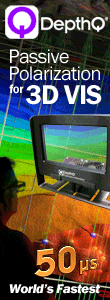



Writing your structured abstract for Stereoscopic Displays and Applications
Stereoscopic Displays and Applications undertakes its first review of papers based on authors’ text-only structured abstracts of 500 words. This is a competitive review and not all papers will be accepted - to maximise your chance of success please make sure your 500 word abstract contains:1) The novel contribution that your paper makes to the field.
2) Technically interesting work that is in the scope of the call for papers.
3) Sufficient detail about your work to allow the committee to make a fair judgement about the relevance and novelty of your contribution.
Writing a good abstract maximises the chance that the program committee will recognise the value of your work, and hence increases the chance of your paper being accepted, we recommend you use the following five clearly headed sections.
CONTEXT: In one or two sentences summarise the background context to your work; clearly state why it is an important question to study.
OBJECTIVE: Describe the purpose of your project, clearly state the problem you set out to investigate in the work you have done.
METHOD: Summarize the technical approach or apparatus you have used or developed in the project. If you are writing a review paper identify the method you used to find primary and secondary sources and how you chose to include or exclude sources from the review.
RESULTS: Describe the results that you have obtained, be as specific as possible and if appropriate quantify the results.
NOVELTY: Please clearly state the novel contribution of your work in comparison to previous publications in the field. If you have previously published in this area, please explain how this work differs from your previous papers.
[NB: These five heading titles should be written in ALL-CAPS in your 500-word abstract since the SPIE abstract system removes all formatting. The 200-word abstract is published and should not include these heading titles.]
Diagrams and Further Information: You can upload a formatted document as an additional file during the abstract submission process. Do this only if there is information that it is not possible to put in the text-only abstract. Examples are graphs and diagrams. Please do not upload an additional document that consists solely of another copy of your abstract: it is frustrating for the committee to download the additional file to find that it contains only the information that they have already read!
References: If you need to include specific references add them at the end of your abstract and include enough information to uniquely identify the work being referenced, (preferably including a link to the reference online, where one exists). Extensive lists of references, if required, can be included in the additional file, rather than in the abstract text.
Number of words: We advise you to use 400-500 words in your abstract. In past years we have had to reject several very short abstracts because they contain too little information for us to make a judgement.
A clear structured abstract helps the program committee review your work. In addition, the evidence from past years is that, if you use the same structure in the abstract of your final paper, it helps others search for and quickly find the contribution of your hard work.
Good luck!
SD&A Programme Chairs